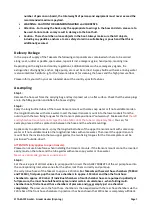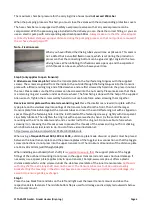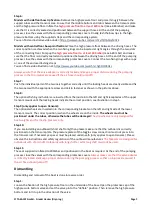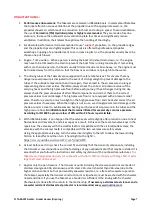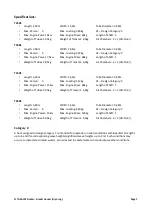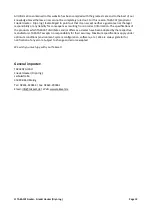
© TAKACAT GmbH - Friedel Hacker (Dipl.-Ing.)
Page
7
Important notes:
1.
Performance enhancement:
The Takacats are catamaran inflatable boats. In catamaran inflatables,
the tunnel effect can cause ventilation at the propeller due to the appropriate swell, i.e. the
propeller shovels air, which leads to a reduction in thrust and a drop in speed. To avoid ventilation,
the use of
Permatrim (TM) Hydrofoil plates is highly recommended
. They are made of marine
aluminum, increase the outboard's anti-ventilation plate four times and significantly reduce
ventilation. In addition, their lateral fins optimise the handling of the dinghy.
2.
For absolute performance it is recommended to use "
cupped
" propellers, i.e. the propeller edges
and the propeller tips are slightly angled. This service is offered by professional propeller
workshops. Cupping of a propeller leads to an increase in pitch, i.e. the propeller usually has to be
chosen one pitch lower.
3.
Engine - Trim position - When a person is sailing the boat is trimmed stern down, i.e. the engine
may have to be trimmed to the stern to prevent the boat from running too steeply. If I am sailing
with more than one person, the boat is usually trimmed neutral or bow-heavy, i.e. the engine must
be trimmed away from the stern so that the bow rises and does not plough into the water.
4.
The driving tubes of the Takacats are equipped with safety relief valves. This ensures that any
dangerous overpressure is dissipated in the event of strong sunlight to prevent damage to the
tubes. If the outside temperature then drops again, this can lead to the air pressures no longer
representing the correct values. Therefore, always check the correct air pressure values of the
carrying hoses and the high pressure floor before each journey. If heat changes during the day,
always check the pressure values of all air-filled components and correct them to the correct
pressure values to avoid damage. The high pressure floor is not equipped with a pressure relief
valve. Therefore, avoid too much sunlight on the high pressure floor and check and correct the air
pressure values if necessary. When the dinghy is not in use, we strongly recommend storage in the
shade or under a cover to avoid excessive heating and increase of air pressure in the tubes and the
high pressure floor.
An inflatable boat that remains inflated for several days can lose pressure.
According to ISO 6185 a pressure loss of 20% within 24 hours is permissible.
5.
With inflatable boats, it can happen that the valve seats settle slightly after production due to heat
fluctuations and movement, and air escapes as a result. In this case there are two valve keys in the
repair box. The valve key with the smaller teeth is compatible with the air inlet/outlet valves, the
valve key with the coarser teeth is compatible with the two overpressure safety valves.
Using the appropriate valve key, turn the valve insert slightly to the left to allow the lower sliding
friction to take effect and then turn it hand-tight to the right=>
https://www.youtube.com/watch?v=wLY4nj24-BE
6.
At least before each trip, check the correct fit and strength of the transom components, including
the transom screw connections and the fastenings of any outboard motor that may be installed. It is
essential that you follow the instructions and safety regulations of the outboard manufacturer.
The
Takacats are designed exclusively for outboards with short shaft. Outboards with long shaft or extra
long shaft must not be used.
7.
Applies only to open transom - The transom mounts including the screw connections are made of
stainless steel grade 304, also known as V2A steel. V2A-steel is harder than V4A-steel due to the
higher carbon content but not permanently seawater resistant, i.e. after each seawater operation
the Takacat, especially the transom construction incl. slip wheels, must be washed with fresh water,
rinsed and dried. If you use the Takacat as a tender it is sufficient if the rinsing with fresh water
(freshwater) is done after the return to the mother ship.
If necessary a stainless steel cleaner and a
seawater resistant stainless steel protector is recommended, see



